Abstract
Liver segmentation from abdominal computed tomography (CT) images is a primary step in the diagnosis and treatment of liver cancer, but previous liver segmentation methods have the problems of excessive demand for prior knowledge, under- and oversegmentation, and boundary leakage. To solve these problems, this paper proposes a new method of liver segmentation to assist doctors in medical judgment. Firstly, a liver reconstruction algorithm is proposed to obtain the approximate initial region of the liver, which reduces the requirement of prior knowledge and can reconstruct the liver region closer to the liver boundary. Then, we refine the edge of the liver region based on the reaction diffusion level set (RD level set). This edge refinement method can effectively deal with the weak boundary problem, prevent under- and oversegmentation, and obtain a more accurate liver region. Our method is verified on the clinical and public datasets, respectively. The segmentation results in terms of mean VOE, RVD, ASD, RMSD, and MSD on dataset Sliver07 are 5.1%, −0.1%, 1.0 mm, 2.0 mm, and 18.2 mm, and on dataset 3Dircadb are 8.1%, −0.2%, 1.5 mm, 2.4 mm, and 20.8 mm, respectively. Compared with the previous algorithms, the experiment results show that this method has a great improvement in accuracy with less prior knowledge. The liver reconstruction algorithm proposed in this paper can obtain a more accurate initial liver region, reduce the requirement for prior knowledge, and reduce time costs compared with the level set algorithm.
1. Introduction
Liver cancer is one of the most lethal tumors in China and the third leading cause of cancer death globally [1,2]. Liver segmentation of abdominal computed tomography (CT) images is widely used in the treatment and evaluation of liver cancer. It is a key point and a prerequisite for liver cancer surgical planning, computer-aided diagnosis (CAD), and other interventional procedures [3]. However, the position, thickness, and angle of liver slices are not fixed, and their possible existential areas and shapes are varied; even the performance of the same liver body in different CT images is also different. Therefore, determining how to effectively process liver CT images to obtain accurate liver parts, so as to judge whether lesions occur efficiently and accurately, is the key to help doctors improve the success rate of judgment.
In recent years, a quantity of methods has been proposed in the field of image segmentation [4,5]. Generally, they can be classified into unsupervised methods and supervised methods. The supervised method is popular because of its efficient ability. However, this method requires a large number of training datasets and is very dependent on the quality of the label datasets. It is also necessary to have strong computing power for this method to be applied in reality [6,7]. There are so many kinds of lesions that the standard segmentation of different datasets will consume enormous manpower and material resources. Therefore, when the label datasets cannot meet the quantity and quality requirements or the hardware conditions are lacking, unsupervised image processing methods are more suitable for image segmentation in the field of medical image segmentation.
Unsupervised image processing methods include level-set-based method, clustering-based method, region-based method, etc.: (1) Level-set-based method. As one of the unsupervised processing methods, level set is widely used in the area of medical image segmentation because of its strong accuracy. Chart and Vese first proposed the CV model in 2001, which combines the traditional active contour segmentation with Mumford–Shah optimization. This model achieves good segmentation effect and strong robustness, but the assumption of the model is that the target and background are homogeneous regions and require large differences in gray values [8]. Subsequently, improved methods based on the CV model have been emerging. Fang J.L. et al. proposed a level set model based on the CV model, which combines global and local information quickly, and constructed a new halting speed function in the driving force, which can segment the image more accurately and quickly [9]. Yang X.P. et al. proposed a hybrid liver segmentation algorithm based on multi seed point level set. Firstly, the fast level set method is used to detect the best initial liver region from multiple seed points, and then the threshold-based level set method is used to extract the actual liver contour. It shows good results in liver image segmentation, but this method is very dependent on the selection mode of the initial evolution contour [10]. (2) Clustering-based method. This method is suitable for solving the fuzziness and uncertainty of gray images, but its clustering effect is very sensitive to the choice of location and number of initial clustering centers. Inspired by the interaction between molecules in chemical reactions, V. Asanambigai et al. proposed the chemical reaction optimization (CRO) algorithm to optimize the global optimal centroid of spatial fuzzy clustering and extract tumors and unhealthy regions in medical images [11]. (3) Region-grown-based method. As an important region-based image segmentation method, the region growth algorithm selects seed points and follows certain seed point growth criteria. It is suitable for the situation where the region to be segmented has the same characteristics. It plays a very important role in the field of medical image segmentation. However, the selection of seed points and the connectivity of regions have a great impact on the accuracy of the region growth method. (4) Fusion method. Bing N.L. et al. first proposed the combination of spatial fuzzy clustering and level set, and used spatial fuzzy clustering to evaluate the performance of medical images with different modes by adjusting the initialization of level set and the optimal configuration of control parameters [12]. On this basis, Li X.C. et al. proposed to refine the liver region by using distance regularization level set and anatomical prior knowledge. However, when selecting the clustering results, it simply divides the abdominal CT into four equal parts. Although this method does not require manual operation, it cannot cover all possible situations [13]. Li D.W. et al. used an optimal search framework, and fused MRF, particle swarm optimization to transform the liver segmentation problem into the optimal value search of implicit function. The abdominal cavity is divided into two parts, A and B, by using the fixed structure of human bones, and it is determined with prior knowledge that the liver region exists in area A, which can find most of the liver region, but in some cases, a small part of the liver region wrongly exists in area B [14]. Yang Q. et al. selected the initial liver region from the result of the fuzzy C-means, and then used the graph cut algorithm combined with the space, shape, and gray characteristics of CT slices to iteratively segment the remaining slices. This method can obtain a more accurate initial region of the liver, but it requires much prior knowledge and interaction [15]. Zheng Z. et al. used the region growth method to roughly segment the liver image, and the segmented results converge to the liver boundary through the level set evolution. Their strong ability to resist edge leakage shows their segmentation advantages. However, the selection of seed points needs a lot of priors, and forced termination is needed at the edge of the level set close to the liver to ensure the effect [16]. On the basis of predecessors, Li Y. et al. proposed a method combining a novel level set integrated with intensity bias and position constraint, a sparse shape composition (SSC)-based method, and improved graph cutting. The strategy based on SSC and graph cutting has outstanding power to address undersegmentation appearing in pathological liver, but its accuracy of liver segmentation from abdominal CT still needs to be improved [17].
In conclusion, unsupervised methods have serious oversegmentation and undersegmentation problems and still need a lot of prior knowledge and interaction when dealing with CT images of different liver tumors. To solve these problems, a liver segmentation procedure, which combines liver reconstruction and RD level set iteration, is proposed. Verified by dataset, this liver segmentation method can reduce interactive cost and obtain more accurate segmentation results at the same time compared with other methods.
2. Materials and Methods
2.1. Data
Experiments were performed using two public contrast-enhanced CT datasets and local clinical datasets, as shown in Table 1, including 55 abdominal CT sequences. The public datasets include 20 Sliver07 training datasets and 20 3Dircadb datasets. Pixel spacing in Sliver07 datasets varies from 0.57 to 0.81 mm, slice thickness varies from 0.7 to 5.0 mm, and slice number varies from 64 to 394. Pixel spacing in 3Dircadb datasets varies from 0.56 to 0.81 mm, slice thickness varies from 1.0 to 4.0 mm, and slice number varies from 184 to 260. The number of pixels in both datasets is 512 × 512. The local datasets from Dongtai Hospital of traditional Chinese Medicine in Jiangsu province include 15 groups of abdominal CT images. Among these datasets, pixel spacing varies from 0.60 to 0.70 mm, format is DICOM, and number of pixels is 512 × 512. The system used in the experiment is Windows10 with CPU Intel(R) HD Graphics 4600, and the software platform is Matlab 2016.

Table 1.
Datasets information.
2.2. Methods
The overall flowchart of our approach is illustrated in Figure 1. The liver CT image segmentation method we proposed is divided into three parts: preprocessing, liver segmentation, and post-processing. Liver segmentation includes a liver reconstruction method and an edge refinement method. The liver reconstruction is carried out to reduce the interference of blood vessels, tissues, and muscles to subsequent segmentation and produce the initial contour, and then the RD level set iteratively refines the segmentation.
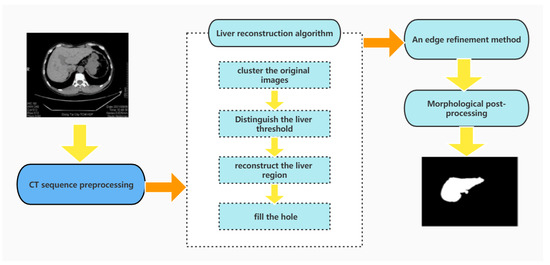
Figure 1.
Flowchart of the proposed method.
2.2.1. Preprocessing
There are artifacts, noise, text information, and other adverse factors in abdominal CT images. Bones, spine, and other organs and tissues whose gray values are similar to those of liver will also affect the segmentation effect. In order to improve the accuracy of segmentation, this paper preprocesses the abdominal CT image: firstly, the image contrast is enhanced by brightness mapping function to reduce the influence of organs and tissues with similar gray values on segmentation. We map the brightness in the gray image to the new value and make 1% of the data have low intensity, high intensity, and saturation. Then, the median filter of 3 × 3 is used to denoise and smooth the image, so as to effectively reduce the artifacts and noise in abdominal CT images, and make the contour of the liver clearer to a certain extent. Finally, we select the threshold according to the distribution of the gray value of the abdominal CT image for threshold segmentation, thus we can remove the parts whose gray value is significantly higher than that of the liver area, such as bone, spine, and text information, and increase the accuracy of the segmented liver image. The T value is set as the threshold. When the gray value is greater than T, we can remove it as spine, rib, and skin, and remove the residual information of the median filter at the same time. When the gray value is between 0 and T, we keep it. The preprocessing process is shown in Figure 2.
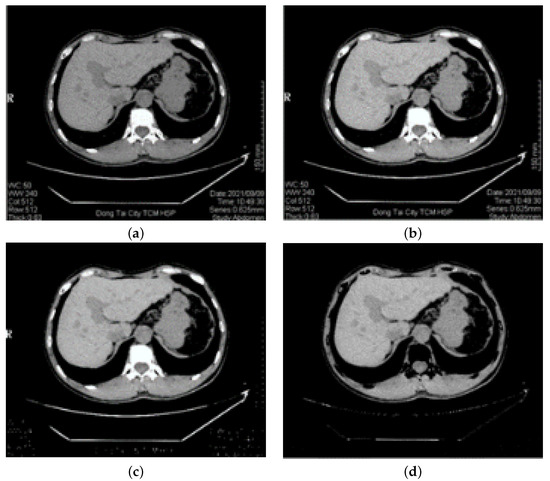
Figure 2.
Preprocessing: (a) The original image. (b) The image after contrast enhancement. (c) The image after median filtering. (d) The image after bone and text removal.
2.2.2. Liver CT Image Segmentation
- Liver reconstruction algorithm
In this paper, we propose a new algorithm to reconstruct the liver region so that we can obtain the initial area of the liver from abdominal CT quickly. In CT images, the performance of liver segmentation will be affected by the existence of noise and artifacts. This influence is particularly obvious in the segmentation process. Firstly, we cluster the original images based on SFCM algorithm proposed by Chuang K S et al. to reduce the influence of organs, muscles, and blood vessels on segmentation [18]. This cluster algorithm adds spatial information to FCM and weakens the influence of noise and artifacts so as to optimize the segmentation effect.
The initial matrix is selected according to the liver CT sequence. The cluster center and membership matrix of each cluster are updated by using Equations (1) and (2), respectively. Once the updated matrix meets the condition or reaches the maximum number of iterations, the iteration stops.
Defined by Formula (3), the variable is introduced to add spatial information to FCM. is a square window with as the center of the liver image.
After repeated experiments, we found that the best segmentation effect can be obtained by setting the sum of contribution weight variables p and q as 1, fuzzy weight index m as 2, the stop threshold as 0.01, and the maximum number of iterations as 100. As shown in Figure 3, the clusters produced by SFCM are divided into three categories: (1) internal organs, including liver, spleen, pancreas, and blood vessels; (2) external adipose tissue and muscle; (3) other parts. We choose the first category, which can clearly distinguish the liver region, as the initial image of subsequent region growth segmentation.
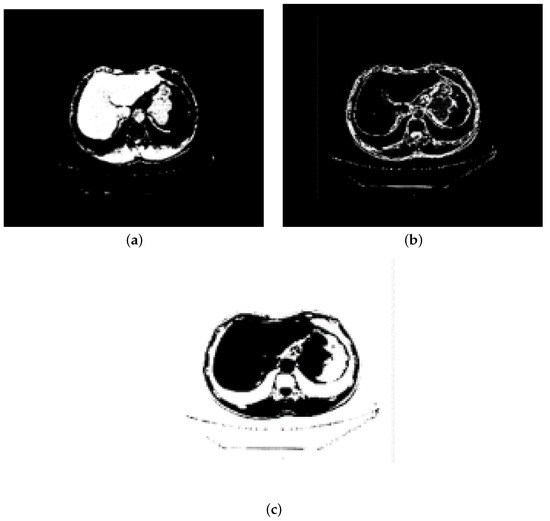
Figure 3.
SFCM clustering: (a–c) show the results after SFCM clustering.
Then, we reconstruct the liver region based on the region growth algorithm which was first proposed by Zucker [19]. It starts from one or more seed points and grows into a set of similar regions to the adjacent regions of the seed points according to certain growth criteria. This paper adopts the region growth based on four neighborhoods. The growth criterion is shown in Formula (4), where S is the average gray value in the grown region, F is the set growth range, and is the standard deviation.
In the process of reconstruction, we found that if we directly grow the cluster results of the first category with liver and other internal organs, there are some disadvantages, as follows: (1) there is a large threshold gap between the liver connected regions of the cluster results, which cannot produce the effect close to the liver boundary (undersegmentation). If we simply change the growth rules, we will produce excessive growth; (2) for the edge refinement method, it is necessary to enhance the balloon force to ensure that the segmented area is close to the boundary, which is prone to oversegmentation, and manual intervention is needed to stop the iteration.
Consequently, this paper proposes a new process to optimize the performance best: (1) First, we distinguish the gray value of the image after clustering and set the threshold value through the gray value range of the image for binary segmentation. (2) Then, we use the reconstruction method based on four neighborhoods to grow the binarized image. (3) Finally, we fill the hole in the reconstruction result. Experimental results are shown in Figure 4: (a) the seed point selection; (b) the regional growth result of the original image without SFCM clustering; (c) the regional growth result of the image with SFCM clustering; (d) the regional growth result of the method in this paper. Note that the results of (b–d) are obtained from the same seed points. It is obvious that the result is better with SFCM clustering than the one without, and the operation taken in this paper can obtain the result closer to the liver boundary.
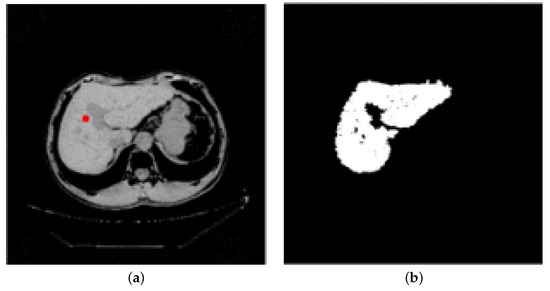
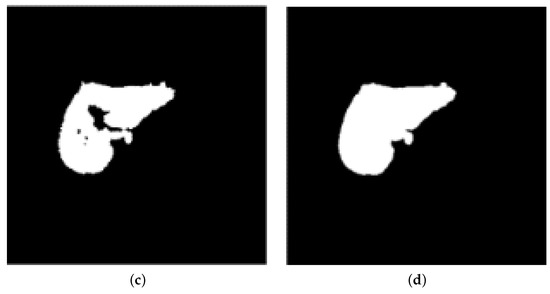
Figure 4.
Comparison results of regional growth of the same seed point: (a) the seed point selection; (b) the regional growth result of the original image without SFCM clustering; (c) the regional growth result of the image with SFCM clustering; (d) the regional growth result of our method.
- 2.
- An edge refinement method
Level set is widely used in the field of image segmentation. The basic idea is to represent the contour as the zero level set in the level set function of one higher dimension, and then transform the evolution of the curve equation into that of the level set function. It not only has the ability to express and aggregate the common topological changes without explicit processing, but also has the ability to automatically handle the common topological changes. However, the level set often needs to be reinitialized at a high cost to ensure the stability of the level set iteration. This paper proposes an edge refinement method based on the level set algorithm with the reaction–diffusion equation, namely, RD level set. This idea, which inspired by the phase transition theory, was firstly proposed by Zhang et al. The method iteratively solves the diffusion equation through the traditional level set and then regularizes the level set function, which eliminates the expensive initialization cost of the traditional level set and has good performance in the leakage resistance of the boundary [20,21].
In this paper, the two-step splitting method (TSSM) is used to iteratively evolve the level set for the segmentation of a liver CT image [21]: (1) iterate the level set equation, and then solve the diffusion equation; (2) regularize the level set function obtained in the first step. The RD level set evolution of a liver image is carried out by using Formula (5).
where is the evolution speed function of level set based on partial differential equation, F is the force function, is a normal number, is Laplace operator, is the initial LSF, and the equation includes two dynamic processes: the diffusion term gradually regularizes the LSF into a piecewise constant function in each segmented region ; the reaction term forces the equation to achieve , so as to obtain the corresponding segmented region. To obtain the best results, after repeated experiments, we set the time step of the level set evolution equation to 0.1 and the time step of the diffusion regularization equation to 0.001.
We take the result after region growth as the initial picture of RD level set to segment, and then refine and track the segmented liver part by using its leak resistance and noise resistance. The experimental results are shown in Figure 5. It is obvious that RD level set can refine and segment the liver well and deal with the leakage of the liver boundary.
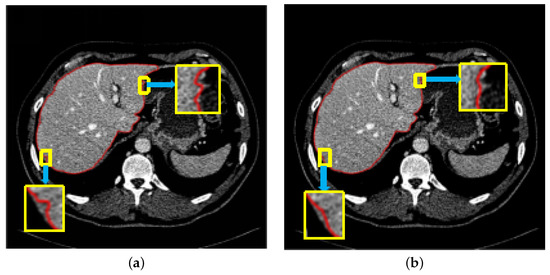
Figure 5.
Comparison before and after using RD level set: (a) Segmentation effect before using RD level set. (b) Segmentation effect after using RD level set.
2.2.3. Morphological Post-Processing
Due to the strong sensitivity of a liver CT to noise, it is easy to have holes in the segmented image. Therefore, mathematical morphology is used for post-processing: we set the adjacent background pixels as the boundary pixels of the object to remove the holes, and smooth the edges by opening and closing operation to achieve the best segmentation effect.
3. Results
3.1. Evaluation Metrics
In order to better evaluate the effect of liver segmentation, this paper selects five evaluation indexes in the literature [22] and Dice coefficient as the segmentation quality evaluation criteria:
- (1)
- Volumetric overlap error (VOE)
- (2)
- Relative volume error (RVD)
- (3)
- Average symmetric surface distance (ASD)
- (4)
- Root-mean-square symmetric surface distance (RMSD)
- (5)
- Maximum symmetric surface distance (MSD)
- (6)
- Dice coefficient
Among them, and represent the segmentation results of each algorithm and the gold standard, respectively. and represent the set of surface voxels of all segmentation results, and , respectively, represent the shortest distance from voxels to and . In this paper, four different algorithms are compared with the algorithm in this paper. Experiments are carried out on 55 groups of liver CT sequences in three datasets. The results are shown in Table 1. In most cases, the algorithm in this paper is better than other algorithms, and the five evaluation indexes show that the accuracy of the algorithm in this paper is higher.
3.2. Experiments and Results
To show the effectiveness of the proposed method, we select some representative abdominal CT images with different shapes, angles, positions, and slice thicknesses for segmentation from 55 CT sequences. Figure 6a–d show the abdominal CT liver segmentation results of our method in the case of no lesions or minor lesions. Figure 6e–h show our method’s segmentation results under the condition of serious lesions. In some of these images, the liver even has obvious lesions, such as (h). The yellow contour represents the segmentation results of the proposed method in abdominal CT, and the red contour represents the results of manual segmentation by experts. We can find that, whether there are lesions or not and whether the shape of the liver changes, the extracted liver region is consistent with that given by experts.
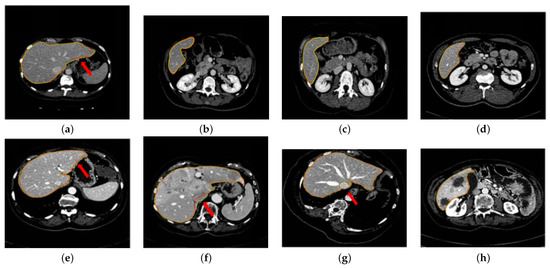
Figure 6.
Representative choice of liver segmentation results by the proposed method: (a–d) show the images in the case of no lesions or minor lesions; (e–h) show the images under the condition of serious lesions.
4. Discussion
Comparison Experiments and Results
To verify the segmentation ability of this algorithm, we counted the Dice coefficients of 40 CT sequences in 3Dircadb and Sliver07 datasets, and the calculation formula is shown in Equation (10). In order to display the Dice coefficients of the segmentation results of each sequence of images more intuitively, we give the box plot of Dice coefficients, as shown in Figure 7. It can be seen from the figure that except for the 16th sequence with serious liver lesions in Sliver07, the segmentation results of other liver sequences are distributed in a small range, reaching a value of more than 0.9, and the distance between the upper and lower quartiles is small, indicating that this algorithm has high segmentation accuracy and good stability.
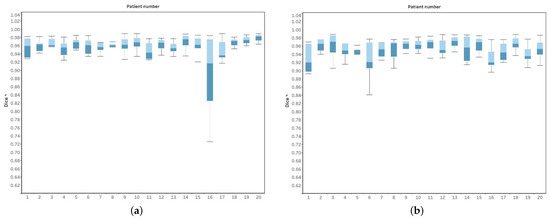
Figure 7.
Box plot of Dice coefficients on Sliver07 and 3Dircadb: (a) Dice coefficients on Sliver07; (b) Dice coefficient on 3Dircadb.
In order to prove the time superiority of this framework, we also randomly selected 100 CT images to segment to compare the time taken by this framework with that of the level set algorithm alone. All these experiments are in the same environment and computer configuration. The result is shown in Figure 8 below, which fully reflects that the speed of this algorithm is faster than that of the level set algorithm.
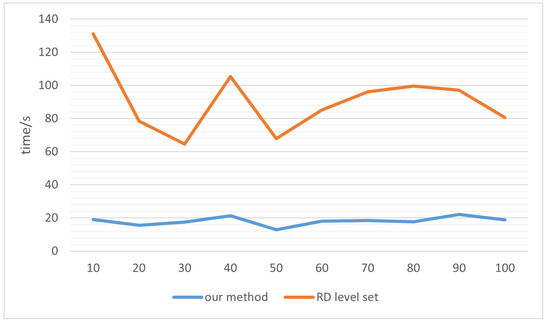
Figure 8.
Time complexity of our method and RD level set.
We also compare the proposed method with the latest methods on 3Dircadb and Sliver07 databases, including traditional liver segmentation methods and methods based on deep learning. Table 2 shows the detailed comparison results of VOE, RVD, ASD, RMSD, and MSD, from which we can observe that the segmentation performance of the proposed method is better than the conventional liver segmentation methods in [10,23,24] and competitive with the method in [17]. The method in [10,23,24] only uses a single segmentation method for liver segmentation, which usually leads to oversegmentation or insufficient segmentation of the liver boundary. The algorithm in [17] first uses the dictionary generated by the normal liver manually drawn by experts to refine the initial segmentation area with SSC. This method requires a lot of prior knowledge and is very time-consuming. Compared with the algorithms in the above literature, our method uses and integrates region growth algorithm, SFCM clustering algorithm, and RD level set, which helps to refine the liver boundary and better deal with the segmentation of liver blood vessels and pathological regions.

Table 2.
Segmentation performance comparison of different methods (A ± B = mean value ± standard deviation).
From Table 2, we can also observe the comparison between our proposed method and the deep learning method [25,26,27]. Reference [25] is an algorithm based on deep belief network. Using a block by block method to train the network will lead to the loss of spatial details in the image and affect the final image segmentation effect of the image. The method in reference [26] is an algorithm for liver segmentation based on deep learning of a three-dimensional convolutional neural network. Its segmentation accuracy depends on the quality of training datasets, and the segmentation performance is not as good as the algorithm proposed in this paper. The method in reference [27] uses the technology based on U-Net and uses five-cross-validation to train the network. The other indicators of this method are similar to the algorithm in this paper, but its maximum surface distance (MSD) is large, which shows that the segmentation effect fluctuates greatly; thus, it may lead to bad results in clinical application.
5. Conclusions
In this study, we proposed a new liver CT image segmentation procedure with a liver reconstruction method and an edge refinement method to segment complex liver images, and we achieved good results. Firstly, we preprocessed the original datasets: the image contrast was enhanced, and the median filter was used to remove the noise and clear boundary in the image background. At the same time, the threshold method was used to separate the spine bones. Then, a liver reconstruction method and an edge refinement method based on RD level sets were used to segment the liver CT image. Finally, after morphological post-processing, good results were obtained. The liver segmentation method we proposed in this paper has the following advantages:
- Our method reduces manual operations and the prior knowledge that doctors need. In liver reconstruction methods, the cluster method based on spatial fuzzy c-means clustering is highly sensitive to the changes of gray and noise, and can alleviate the problem of weak boundary. After clustering, the seed points of region growth can be selected without too much prior knowledge. The seed points inside the liver area of the picture can be selected arbitrarily, which greatly avoids the problem that tumors and other lesions are wrongly selected as the seed points by the traditional methods, and reduces a lot of manual operations as well.
- Our method reduces the influence of external tissues and muscles and avoids undersegmentation or oversegmentation. Compared with directly thresholding the original image before reconstruction, thresholding after clustering can minimize the impact of external tissues and muscles on regional growth results and avoid the common undersegmentation or oversegmentation of reconstruction.
- Our method reduces time complexity and increases leak resistance and noise resistance. After clustering, the reconstruction results are closer to the liver boundary, which reduces the number of iterations of the level set and the time complexity of the algorithm. The result of liver reconstruction in this method is used as the initial segmentation region of edge refinement method, which reduces the risk that the reconstruction result is far away from the liver boundary region, avoids the situation that the segmentation result is not ideal due to the need to use too much balloon force, and makes use of the leak resistance and noise resistance of RD level set to make the result more accurate.
However, there are still some deficiencies in this method. For example, the proposed method is not a fully automatic method. Although it does not need too much prior knowledge, it still needs to manually select the seed points for reconstruction to ensure the growth effect. Future work will focus on solving the limitations of the liver segmentation algorithm, and apply this method to the segmentation of other abdominal organs, so as to provide reference for medical clinical experiments.
Author Contributions
S.-Q.Y. was in charge of supervision and funding acquisition. T.Z. designed the methodology and conducted the experiments for this research. Y.-H.W. created algorithm methodology and conceptualization and C.L. performed the formal analysis and revision of the manuscript. All authors have read and agreed to the final version of the manuscript.
Funding
This research was funded by the National Social Science Foundation grant number 22GBL198 and the Key Program of Hunan Provincial Education Department grant number 20A120.
Data Availability Statement
The datasets analyzed during the current study are available in the [3Dircadb] repository and [Sliver07] repository, http://www.ircad.fr/research/3d-ircadb-01 (accessed on 12 May 2021); www.sliver07.org, (accessed on 12 May 2021).
Acknowledgments
This work was supported in part by the the Young Program of National Natural Science Foundation of China under Grant No. 62002115.
Conflicts of Interest
The authors declare no conflict of interest.
Abbreviations
The following abbreviations are used in this manuscript:
| CT | Computed tomography |
| SSC | Sparse shape composition |
| SFCM | Spatial fuzzy c-means |
| RD level set | Level set method combined with reaction diffusion equation |
| CT | Computed tomography |
| CAD | Computer-aided diagnosis |
| CRO | Chemical reaction optimization |
| VOE | Volumetric overlap error |
| RVD | Relative volume error |
| ASD | Average symmetric surface distance |
| RMSD | Root-mean-square symmetric surface distance |
| MSD | Maximum symmetric surface distance |
References
- Bhan, A.; Mangipudi, P.; Goyal, A. Deep Learning Approach for Automatic Segmentation and Functional Assessment of LV in Cardiac MRI. Electronics 2022, 11, 3594. [Google Scholar]
- Ahamad, A.; Sun, C.C.; Kuo, W.K. Quantized Semantic Segmentation Deep Architecture for Deployment on an Edge Computing Device for Image Segmentation. Electronics 2022, 11, 3561. [Google Scholar] [CrossRef]
- Shi, C.; Xian, M.; Zhou, X.; Wang, H.; Cheng, H.D. Multi-slice low-rank tensor decomposition based multi-atlas segmentation: Application to automatic pathological liver CT segmentation. Med. Image Anal. 2021, 73, 102152. [Google Scholar] [CrossRef] [PubMed]
- Chouhan, S.S.; Kaul, A.; Singh, U.P. Image Segmentation Using Computational Intelligence Techniques: Review. Arch. Comput. Methods Eng. 2018, 2, 1–64. [Google Scholar] [CrossRef]
- Chouhan, S.S.; Kaul, A.; Singh, U.P. Soft computing approaches for image segmentation: A survey. Multimed. Tools Appl. 2018, 77, 28483–28537. [Google Scholar] [CrossRef]
- Goceri, E. Formulas behind deep learning success. In Proceedings of the International Conference on Applied Analysis and Mathematical Modeling (ICAAMM2018), Istanbul, Turkiye, 13–18 September 2018. [Google Scholar]
- Goceri, E.; Gooya, A. On the importance of batch size for deep learning. In Proceedings of the International Conference on Mathematics (ICOMATH2018), An Istanbul Meeting for World Mathematicians, Istanbul, Turkiye, 3–6 July 2018. [Google Scholar]
- Chan, T.F.; Vese, L.A. Active contours without edges. IEEE Trans. Image Process. 2001, 10, 266–277. [Google Scholar] [CrossRef]
- Fang, J.L.; Lu, Y.B.; Wang, Y.Z.; Tang, S.N.; Wu, D.A. A Novel Medical Image Segmentation Algorithm Based on Level Set. Electron. Sci. Technol. 2021, 34, 12–20. [Google Scholar]
- Yang, X.; Yu, H.C.; Choi, Y.; Lee, W.; Wang, B.; Yang, J.; Hwang, H.; Kim, J.H.; Song, J.; Cho, S.H.; et al. A hybrid semi-automatic method for liver segmentation based on level-set methods using multiple seed points. Comput. Methods Progr. Biomed. 2014, 113, 69–79. [Google Scholar] [CrossRef]
- Asanambigai, V.; Sasikala, J. Adaptive chemical reaction based spatial fuzzy clustering for level set segmentation of medical images. Ain Shams Eng. J. 2018, 9, 1251–1262. [Google Scholar]
- Li, B.N.; Chui, C.K.; Chang, S.; Ong, S.H. Integrating spatial fuzzy clustering with level set methods for automated medical image segmentation. Comput. Biol. Med. 2011, 41, 1–10. [Google Scholar]
- Li, X.; Luo, S.; Li, J. Liver segmentation from CT image using fuzzy clustering and level set. J. Signal Inf. Process. 2013, 4, 36. [Google Scholar] [CrossRef]
- Li, D.W.; Wang, J.; Chen, J.B.; Li, H.S. Liver Segmentation by Using an Optimal Framework for CT Images. Chin. J. Comput. 2016, 39, 1477–1489. [Google Scholar]
- Yang, Q.; Qian, Y.Q.; Zhang, F.; Liao, M. Liver segmentation from CT volumes based on spatial fuzzy C-means and graph cuts. Laser Optoelectr. Sens. 2022, 59, 430–439. [Google Scholar]
- Zheng, Z.; Zhang, X.C.; Zheng, S.M.; Shi, Y.D. Liver segmentation in CT images based on region-growing and unified level set method. J. ZheJiang Univ. Eng. Sci. 2018, 52, 2382–2396. [Google Scholar]
- Li, Y.; Zhao, Y.Q.; Zhang, F.; Liao, M.; Yu, L.L.; Chen, B.F. Liver segmentation from abdominal CT volumes based on level set and sparse shape composition. Comput. Methods Progr. Biomed. 2020, 195, 105533. [Google Scholar] [CrossRef]
- Chuang, K.S.; Tzeng, H.L.; Chen, S.; Wu, J.; Chen, T.J. Fuzzy c-means clustering with spatial information for image segmentation. Comput. Med. Imaging Graph. 2006, 30, 9–15. [Google Scholar] [CrossRef]
- Zucker, S.W. Region growing: Childhood and adolescence. Comput. Graph. Image Process. 1976, 5, 282–299. [Google Scholar] [CrossRef]
- Turk, G. Generating textures on arbitrary surfaces using reaction-diffusion. ACM Siggraph. Comput. Graph. 1991, 25, 289–298. [Google Scholar] [CrossRef]
- Zhang, K.; Zhang, L.; Song, H.; Zhang, D. Reinitialization-free level set evolution via reaction diffusion. IEEE Trans. Image Process. 2012, 22, 258–271. [Google Scholar] [CrossRef]
- Heimann, T.; Van Ginneken, B.; Styner, M.A.; Arzhaeva, Y.; Aurich, V.; Bauer, C. Comparison and evaluation of methods for liver segmentation from CT datasets. IEEE Trans. Med. Imaging 2009, 28, 1521–1565. [Google Scholar] [CrossRef]
- Li, G.; Chen, X.; Shi, F.; Zhu, W.; Tian, J.; Xiang, D. Automatic liver segmentation based on shape constraints and deformable graph cut in CT images. IEEE Trans. Image Process. 2015, 24, 5315–5329. [Google Scholar] [CrossRef] [PubMed]
- Lu, X.; Wu, J.; Ren, X.; Zhang, B.; Li, Y. The study and application of the improved region growing algorithm for liver segmentation. Optik 2014, 125, 2142–2147. [Google Scholar] [CrossRef]
- Ahmad, M.; Ai, D.; Xie, G.; Qadri, S.F.; Song, H.; Huang, Y. Deep belief network modeling for automatic liver segmentation. IEEE Access. 2019, 7, 20585–20595. [Google Scholar] [CrossRef]
- Lu, F.; Wu, F.; Hu, P.; Peng, Z.; Kong, D. Automatic 3D liver location and segmentation via convolutional neural network and graph cut. Int. J. Comput. Assist. Radiol. Surg. 2017, 12, 172–182. [Google Scholar] [CrossRef] [PubMed]
- Sakboonyara, B.; Taeprasartsit, P. U-Net and Mean-Shift Histogram for Efficient Liver Segmentation from CT Images. In Proceedings of the 2019 11th International Conference on Knowledge and Smart Technology (KST), Phuket, Thailand, 23–26 January 2019. [Google Scholar]
Publisher’s Note: MDPI stays neutral with regard to jurisdictional claims in published maps and institutional affiliations. |
© 2022 by the authors. Licensee MDPI, Basel, Switzerland. This article is an open access article distributed under the terms and conditions of the Creative Commons Attribution (CC BY) license (https://creativecommons.org/licenses/by/4.0/).